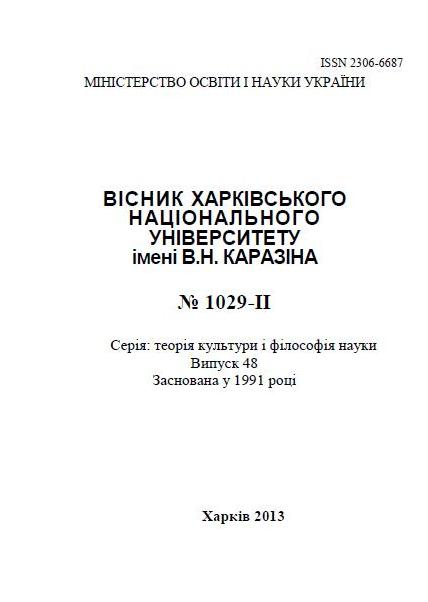ВИЗУАЛЬНЫЙ ОБРАЗ КОСТЮМА: ФИЛОСОФИЯ МОДЫ В ВИЗУАЛЬНЫХ ИССЛЕДОВАНИЯХ
Анотація
Проблема исследования феномена моды и индустрии моды заключается в том, что
основная база исследовательских материалов предыдущих лет (это прежде всего
социологические и семиотические) не раскрывают в полной мере сущности этого
феномена. Поэтому актуальным на данный момент является смещение акцента в
визуальное поле, и таким образом, междисциплинарное и более широкое. Т.к. индустрией
моды образец создается виртуально, не как вещь, а как образ, имеет место
типологизации визуального модного образа.
Царевська О.Ю. ВІЗУАЛЬНИЙ ОБРАЗ КОСТЮМУ: ФІЛОСОФІЯ МОДИ У
ВІЗУАЛЬНИХ ДОСЛІДЖЕННЯХ Проблема дослідження феномена моди та індустрії
моди полягає в тому, що основна база дослідницьких матеріалів попередніх років (це
насамперед соціологічні та семіотичні) не розкривають повною мірою сутності цього
феномена. Тому актуальним на даний момент є зміщення акценту в візуальне поле, і
таким чином, міждисциплінарне і більш широке. Т.я. індустрією моди зразок
створюється віртуально, не як річ, а як образ, має місце типологізації візуального
модного образу.
Ключові слова: індустрія моди, модний образ, візуальність, фатіческій модний образ,
образ-інсталяція, подіумний образ.
Tsarevska E.U. VISUAL IMAGE OF COSTUME: PHILOSOPHY OF FASHION IN THE
VISUAL STUDIES Each of the classical concepts reflected the social nature of fashion as it was
in a certain era. The modern fashion is a specific phenomenon, that appears as industry.
Fashion like industry is specialized production of modern and original models which is
organized on the principles of rationality. Understanding of what is produced not an actual
model, but trendy - modernity and originality becomes essential. They express, respectively, the
desire for otherness, identity, on the one hand, and general following for all "spirit of the time"
on the other. The fashion industry has created a virtual model, not as a thing, but as an image.
This situation is similar to what J. Bodriiar describes, saying about the priority models of
reality. [2] In today's fashion world the spread of samples across reference groups are
simulated. The models in the magazines and TV ads are served not only as an object of a certain
size, color, texture, but as a desired image of social status, interpersonal relationships, etc.
Photographers and designers are not so much concerned with showing all the features of the
model, but rather the creation around it the virtual social environment.
By engaging in the process of changing fashion models, people not only acquire and use
things but bring the model into social reality. Fashion, as it becomes the industry, is the
reproduction of social reality in the form of its simulation.
Thus, by far the most extensive observations on the mechanism of fashion are accumulated
regarding to his external appearance and his costume. This fact LV Petrov explains in following:
architecture, music, painting professionally are involved in small groups. The clothes are worn
by all. That is why in the appearance of man the fashion is most clearly and visibly, and is
universal [13, p.4].
During this period, fashion has been studied mainly as a mass communication process,
because in the operation mode involves in its sphere large groups of people and fashion
messages occur with the use of technical means of information reproduction (press, radio,
television, film).
B.D.Parygin sees fashion as a specific and dynamic form of standardized mass behavior that
occurs mostly spontaneously under the influence of the dominant attitudes in society and rapidly
changing tastes and hobbies. The author considers the etymology of the fashion and comes to the
conclusion that the etymological definition of fashion does not reveal its social essence, but it
shows that the concept of fashion is socio-historical.
Although the word "fashion" has penetrated into all the European languages, but it has
failed to dislodge them from the other words related to it within the meaning of "taste", "fancy",
"style", "hobby", and others. Therefore Parygin considers necessary to consider the relationship
of concepts of fashion and taste, custom, culture, and advertising. The results of this review are:
taste as a type of fashion let people in ancient times to give subjects of aesthetic appreciation of
his work. Fashion - on the one hand, is the stage in the development of mass taste, and on the
other hand – is a form of development. Fashion - is a form of public taste that exists objectively
regardless of our individual consciousness, taste. The structure of society influences on fashion
and taste, stratifying them.
In the mass consciousness of the everyday phenomenon of fashion it's often related only to
the specific cultural sphere - a sphere of clothing. Obviously, such an approach is due to
vagueness of the concept of fashion, which, on the one hand, the meaning of some of the
phenomena that are characterized by high variability in any culture, and on the other hand - the
same phenomenon only in culture clothing. Such inconsistency of meaning often leads to
differences in understanding the phenomenon of fashion. But the same problem we face, for
example, using the concept of "culture." On the one hand a culture understands all that man can
do, all aspects of his activities, and the other - in this concept are invested purely ethical or
aesthetic sense.
Key words: Fashion industry, visual Studies, fashionable image, phatic fashionable image,
image-installation, podium image, semiotics.




